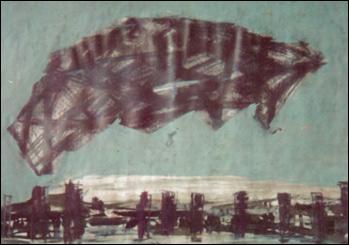Zoran Jovicic at Gallery S.U.L.U.J.
 |  |
The Gallery S.U.L.U.J. is located in the strict center of Belgrade. The initials stand for the Association of Fine Artists of Yugoslavia-a namewhich hasn’t changed despite the fact that the country has recently become Serbia and Montenegro.
Unlike other local galleries that exhibit trendy work whose content is so predictable that an art lover loses the habit of even entering, this gallery offers a number of surprises. One never knows what to expect while climbing the stairs of a decadent old building, which at the beginning of the last century harbored the collection of the National Museum of Art. The gallery itself is located on the second floor of this historic building.
This May the gallery hosted a very interesting painting exhibition by Zoran Jovicic. Jovicic rarely exhibits, and when he does, he shows a different approach and aspect of his sensibility.
In this exhibition Jovicic continues with the visual-psychological research of deciphering the city as a civilizational phenomenon. After analyzing the ruined facades of the old city core, he transfers his interest to the modern residential blocks of New Belgrade (a settlement built during the time of communism).
He divides his work into two parts: The lower, in which the motive varies from recognizable building groups to completely abstract planes, and the upper in which the phantasmagoric shapes are transformed and multiplied.
The associations vary from ominous clouds, threatening webs and frightening creatures, to easy flyers, good-natured giants or curious androids. The tedious and monotonous repetition of urban verticals in the lower part, the infinite piling up of relentlessly similar shapes arouses the artist to visually and psychologically revolt .
While in the lower parts of the work barely marks these monolithic masses, in the upper he resolves his anxiety and tension projected in constantly transforming fantasy constructions. They are the embodiments of the artist’s emotional reaction to the dissonance in which he finds himself while constantly searching for ever evasive harmony.
The relationship and the interaction of these two planes (the sky and the ground) give these small paintings great intensity. They emit the artist’s aesthetic despair by contemplating the urban desert .
It is important to note that these works (gauche on paper) were intentionally done over the expressionistic gesture pencil drawings made by the artist twenty-five years ago. Showing through the layers of paint in the upper part of the pictures, they now constitute the mentioned phantasms. This effective weaving of layers contributes to the complexity of meaning and associations.
These small and quick paintings, real and phantasmagoric at the same time, were not meant to be attractive. Dynamic both in gesture and form, and always with a plethora of tension, they demand an engaged and alert observer.




